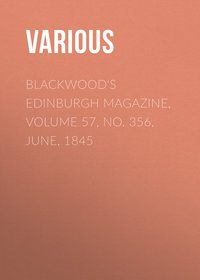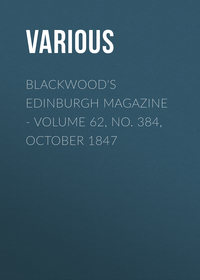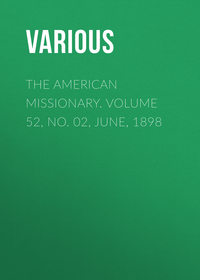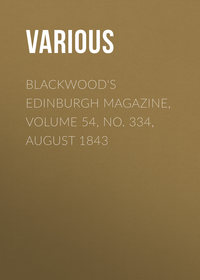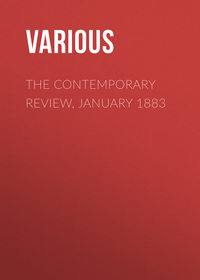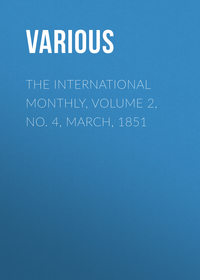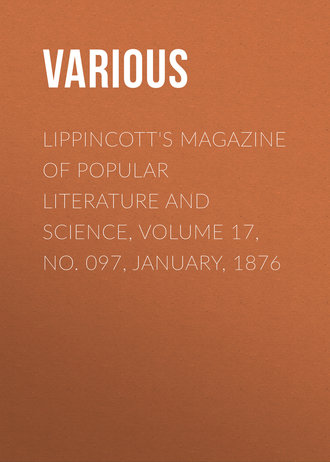 полная версия
полная версияLippincott's Magazine of Popular Literature and Science, Volume 17, No. 097, January, 1876
Leaving the spring behind us, we pass up the long lane between two cotton-fields of a hundred acres each, in which the blackened stalks are still standing, as are the dried cornstalks and gray pea-vines in the field beyond. These will remain until the early spring, when they will be cut down and "listed in" with the hoe, for not a foot of this rich and profitable plantation has ever been broken with the plough. Incredible as it may appear, there is not a plough or a work-horse, and but one old mule, upon this highly-cultivated tract of one thousand acres. All the hauling is done by ox-teams, with three sturdy negroes to each cart, and the heavy cotton-hoe does everything else. Where one man and a plough could till three acres, twenty men and women with hoes 'ridge up the ground, scatter manure in the furrows, and draw the ridges down on it again. True, the surface only is scratched, and the soil is soon exhausted, but who cares for that when there is abundance of rich timber-land from which to clear new fields? and as to economizing labor, that is the last thing a planter cares about, for what are the negroes to do? None are ever sold, the "picknies" who swarm around every cabin growing up to stock the plantations bought for each child as he or she "comes of age or is married," and work has to be made for them to do.
"What shall I put the hands at to-day, sir?" asked an overseer of an old planter when the last bale of cotton had been packed.
"Hum! let's see! Well, set them to filling up the old ditches and digging new ones."
For the same reason power-gins and saw-mills found little favor, the single-treadle "foot-gin" and the saw-pit and cross-cut employing ten times as many hands. It was the aim of every large planter to produce and manufacture by hand-power everything needed on the place. Of course, it required a heavy expenditure of labor and land to raise provisions for such an army of unprofitable workers, on which account slave capital was the poorest paying property in the world. The planter was wealthy, but he owned only land and negroes: when the latter were emancipated the former became useless; and this is the reason why the war so utterly ruined the rich land-owners of the South.
ROBERT WILSON.OUR MONTHLY GOSSIP
'76
Pass, '75, across the Styx!Make way for stately '76,Who comes with mincing, minuet pace,Well-powdered hair and patch-deckt face—An antiquated kerchief on:White-capped, like Martha Washington;Clock-hosed and high-heeled slipper-shod,To give no Nineteenth Century nod;Nay, but a courtesy profound,Whose look demure consults the ground.O rare-seen bloom! No flower perennial,This aloe-crowned Dame Centennial!She comes with shades of days long fled—Knee-breeched; long silk-stockingèd;Well-braided queues; bright-buckled shoonThat flash with diamonds; gold galloonOn rebel uniforms of blue–A color that this land found true;Three-cornered hats, and plumes that flewThrough conflicts where men dare and do.A patriot throng, a gallant host,Our Dame Centennial's train can boast.O aloe-flower upon her brow!Of what strange birth-pangs breathest thou,The while we gaze with dreamy eyesBack o'er a sea of memories,And see thy seed of foreign skiesHere washt, to spring beneath our sunAnd ripen till its bloom is won!What storms have rocked thy stem aslant,O changeful-nurtured Century-Plant!Whose living flower now opens blandIts kindly promise o'er the land!With blood and tears 'twas watered,The bud whose blossom now is spreadA floral cap her head upon,Who, à la Martha Washington,Our Dame Centennial now appears,Our '76, our crown of years!Brave preparations thee await,O dame arrayed in olden state!For thee, for thee, Penn's city standsAnd stretches forth inviting handsTo guests of home and foreign lands,And gathers all historic prideOf ancient records at her side,With gifts from all, on thee to rainWho bring'st such mem'ries in thy train.Hail, city well named "Brother's Love!"The Quaker City of the dove,That fain would call a land to flingIts spites away, and 'neath thy wingRenew the treaty made by PennIn the wildwood with wilder men;Yet true men still! Be this the token–loyal faith, a pledge unbroken!O year that wear'st thy aloe-flowerSo proudly! may thy touch have powerOf healing! May thy visage blandDrive threatening discord from the land,And thronèd Peace more firmly fix!Then shall the elder '76,From out the eighteenth century's bandOf Time's host in the shadowy land,Greet thee as one true soul may smileUpon another, where nor guileNor sorrow can its brightness dim.So greet the clear-eyed seraphim—So once in Eden's sinless bowerUnfading flower smiled on flower.LATIENNE.THE KREUZESSCHULE
OBER-AMMERGAU, Bavaria, Oct. 4, 1875
The town lies at the end of a lovely green valley. Behind it are fir-clad mountains with rocky peaks: on one side a great square rocky peak, which towers above all and is surmounted by a cross. On each side of the valley sloping hills, fir-clad to the top. A rapid, clear stream runs by on the edge of the village. Green pastures dotted with haymakers, a few scattered trees and a distant town fill the charming valley. Virginia creepers hang on the walls, and gay flowers fill pretty balconies and peep through sunny little casements. All is simple and neat, and the bright fresco pictures on the fronts of many houses lighten it all.
On a high hill overlooking the town they are placing a colossal crucifixion group, presented by King Ludwig II. in Erinnerung an die Passionsspiele—in memory of the Passion play—Christ on the cross, with the Virgin and St. John, one on each side. The two latter were ready to be hoisted on to the pedestal: the former is partly up the hill. All are surrounded by heavy planking, so that it is impossible to judge of the artistic merit, but the great group cannot fail to have a fine effect when viewed from a distance.
Yesterday (October 3d) was the eventful day. Our tickets had been ordered by telegraph, and we had "the best seats." The performance was to begin at nine o'clock, and at a quarter before nine we were in our places.
The building in which the play is given is of plain rough wood without paint ("or polish"); in the interior a gallery and two side-galleries, below them a parterre, and on each side of it a standing-place, all of plain, unpainted boards. The orchestra was sunk below the level of the stage, the proscenium painted to represent columns and entablature. The curtain represented, or seemed intended to represent, Jerusalem. The whole place could not probably contain over six hundred people, and was about half full. There were very few foreigners.
The play to be represented was not the "Passion play," which is given every ten years, but the Kreuzesschule, which is played once in fifty years—last in 1825. In it the play is taken from the Old Testament, and the tableaux from the New Testament—the reverse of the Passion play.
The orchestra began punctually at nine o'clock. There were about twenty performers, and they played with skill and taste. The selection of music was admirable. They commenced with a sort of prelude, slow and declamatory. Perfect silence reigned, and the deep interest of the spectators was, from the first and throughout, shown in their expressive faces. Men and women at times shed tears, and made not the slightest effort to hide their emotion. The black head-*kerchiefs of many of the women spectators, tight to the skull with ends hanging down behind, seemed in harmony with the scene.
The prelude ended, the Chorus entered with slow and dignified pace—seven men and women from one side, six from the other, all in a kind of Oriental costume, picturesque and handsome. The tallest came first, and so on in gradation, so that when ranged in front of the curtain they formed a kind of pyramid. The central figure then began the prologue, an explanation. Then the basso commenced singing an air, during which the Chorus divided, falling back to the sides and kneeling, while the curtain rose, displaying the first tableau. This lasted nearly three minutes, during which time the figures were really perfectly motionless. The basso finished his air and the tenor sang another while the curtain was up. This tableau represented the cross supported by an angel, while grouped around were men, women and children looking up at it in adoration. This was the "Kreuzesschule"—the school of the Cross—the prologue to the piece. The picture had the simplicity of the best school: no affected attitudes—all plain, earnest and beautiful. When the curtain fell the Chorus again took their places in front of it, a duet was sung, then a chorus, and then they countermarched and retired in quiet dignity.
Then came the first part. A prelude by the orchestra, and the curtain rises on Abel, dressed in sheep skin, by his altar, from which smoke ascends, he returning thanks. Enter Cain in leopard skin, much disturbed and angry. They discourse, Abel all sweetness, Cain bitter and cross. An angel in blue mantle, like one of Raphael's in the "Loggia," appears at the side and comforts Abel. Then Eve in white dress—evidently it had been a puzzle to dress her—and buskins, who says sweet words to Cain. Then Adam in sheep skin, very sad at all this difficulty. Eve sweetly strives to reconcile Cain to his brother, and appeals to him with much feeling. He discourses at length, then appears to relent and embraces Abel, but is evidently playing the hypocrite, and as the curtain falls you see that hate is in his heart.
The curtain down, the orchestra plays a prelude, the Chorus enters as before, and the leader speculates on Cain's behavior. "Is he honest?"—"Ah no, his heart is full of hate: he meditates evil." The Chorus divides as before, falls back and the curtain rises. This tableau represents the hate and rage of the people and Pharisees toward Christ, who drives the traders out of the Temple. In grouping, costume, color, tone, action and completeness it was truly a marvelous picture. The stage was crowded with figures: Christ in the centre, behind—a row of columns on each side—a scourge in his left hand, his right upheld in admirable action; in the background a group in wild confusion; on the right, richly dressed priests and Pharisees, indignant and fierce; in front, sellers of sheep and doves, money-changers and traders of various kinds. All the elements of a great picture were here shown in the highest degree, and no words of praise could be too strong to express the idea of its merits and its charm. This tableau lasted nearly two minutes, with the most complete steadiness, the basso singing an aria. The curtain then fell, and the Chorus, taking its place, sang and retired as before. This ended the first part, Cain's hate prefiguring the hatred toward Christ.
Then came Part Second. The curtain rose on Cain by the side of his ruined in a soliloquy. Enter Abel, gentle and mild. Eve comes in, and again tries to make peace, and Cain again plays the hypocrite and invites his brother into the wood on some pretext. They retire, leaving Eve disturbed by she knows not what. Adam enters, shares her fears and goes out to seek his sons. Thunder and lightning, admirably represented, and then enter Cain disheveled and disturbed. His mother knows not what has happened, but is agonized and calls for her Abel. An angel appears at the side and discloses all by asking Cain, "Where is thy brother?" and then announcing the fiat of the Most High to him. He rushes off as Adam enters bearing the body of Abel; and his mother, sitting down beside the dead body, makes a most touching picture of a Pietà. Adam with upstretched arms appeals to God, and the curtain falls. This was the "Blutschuld"—the crime of blood—and prefigured the betrayal of Christ by Judas for the thirty pieces of silver.
After a most beautiful prelude by the orchestra, the Chorus again enters; the leader expresses his horror at Cain's action and his pity for a fate thus given over to Satan; they again divide, and the curtain rises on the tableau of Judas receiving the money. At the end the high priest and other priests, in appropriate costume, stand on a platform beyond a railing. Judas in the centre, by a table, is taking the money from an attendant: all around are groups, admirably arranged, expressing, in face and attitude, wonder or pleasure or disgust. The same artistic ideas and beautiful arrangement and the same unaffected simplicity. This tableau lasted one minute and a half, while the tenor sang an aria, "Oh, better for him that he had never been born."
The third part was Das Opfermahl—the offering of bread and wine by Melchisedek to Abraham, prefiguring the Last Supper. Prelude by orchestra. The curtain rises, displaying Melchisedek before an altar, on which are bread and wine. Four attendants are near him. He, in a flowing white robe, discourses to them. The scene is simple and natural. Enter Abraham and attendants on one side and Lot and attendants on the other, all dressed in Roman mantles, buskins and helmets. The stage was filled and the grouping admirable. Abraham and Lot discourse, embrace and part, Lot and his followers retiring. Melchisedek comes forward and addresses Abraham, who replies at some length. Then Melchisedek prepares his bread and wine, takes some, then offers to Abraham, who eats and drinks. Meantime, a most charming chorus of Handel is sung behind the scenes, while Melchisedek and his attendants offer the bread and wine to all of Abraham's suite, who partake reverentially. Tableau and chorus, and the curtain descends. The ease and simple quiet action of all this scene were remarkable.
Enter Chorus as before: leader speaks. They divide and the curtain rises on the tableau of the Last Supper. I know not whether it was taken from any one picture—I think not—but it was simply and effectively grouped, and it recalled both Lionardo and Andrea del Sarto. This lasted two and a half minutes, during which time the contralto sang an air of Mozart's.
The fourth part—Die Ergebung (Resignation)—was represented in the play by Abraham's willingness to sacrifice his son at God's command, prefiguring the agony of Christ in the Garden.
After a prelude by the orchestra the curtain rose and discovered Abraham and Isaac in loving discourse, with figures in the background, admirably costumed and grouped. An angel in white robe and blue mantle appears and delivers his heavenly message to the astounded Abraham. His agony was simply and feelingly depicted. He appears at last resigned, when Sarah, in red robe and Eastern headdress, enters to renew his grief. The beauty of this woman was of the highest order in feature and expression, and her dress was truly artistic. The scene between these two was most touchingly acted. Isaac reappears, thinking that he is simply going on a journey, and, scarcely comprehending his mother's great grief, presents his companion to her as a comfort and stay, thus prefiguring John and Mary at the cross. Abraham and Isaac depart, and the curtain falls.
Then another prelude by the orchestra, and the Chorus appears: the leader delivers the epilogue. They divide and kneel, and the curtain rises on the tableau of the scene in Gethsemane.
Christ, on an elevation, is kneeling: an angel stands in front of him. Below, the apostles are all asleep in groups. Behind, in the centre, Judas advances with the soldiers, who bear tall lanterns. It was like a picture of Carpaccio, and worthy of that great master. This tableau lasted two and a quarter minutes, during which time the tenor sang an aria.
The fifth part—Es ist vollbracht (It is fulfilled)—represents Abraham going out to sacrifice his son, prefiguring the Crucifixion. The curtain rises on Sarah, full of agony, which is most simply and powerfully depicted. Attendants enter, who tell a long story: then Abraham and Isaac appear, and there is a most striking scene—Sarah fainting, the friend sustaining her, the others grouped around in various picturesque attitudes. An angel appears, simple and practical, like those of the good old painters, and delivers the blessing. The curtain falls.
Again the orchestra in a superb prelude: then the Chorus appears, and, after the epilogue, divides and kneels as the curtain rises on a tableau which my imagination never could have pictured, for its wonderful completeness, its power, its feeling, its artistic beauty and its marvelous expression far exceeded any idea that I had of the power of men and women to represent such a picture—the Crucifixion.
The stage was crowded with figures, Christ in the centre, fully extended on the cross, with no signs whatever of support to disturb the illusion—the thieves on one side and the other, with arms over the cross, as frequently represented; the group at the foot of the cross so touchingly tender—the soldiers, the priests, the people—all grouped with such consummate skill, such harmony of colors, such appropriateness and vigor of expression, as have never, to my thinking, been excelled in the greatest pictures of the greatest masters. Here was most remarkably shown the wonderful artistic talent and feeling of these simple people. There was nothing repulsive in any way, scarcely painful, except tenderly so. You breathlessly gazed on this wondrous scene, and when, after three minutes, the curtain fell, you were speechless with admiration and emotion. A lovely air by the soprano accompanied this tableau, and after the curtain fell a grand chorus completed the fifth part.
The sixth part—Durch Dunkel zum Lichte (through Darkness to Light)—ended the programme. The play represented Joseph, with all his honors upon him, receiving his old father and his brothers—prefiguring the Ascension of Christ.
After the prelude by the orchestra the curtain rises and discovers old Jacob, surrounded by his sons in various groups. The scene and costumes were admirable and appropriate. In the midst of a discourse Joseph bursts in in fine attire, followed by a great train, among which are two darkies, taken bodily from Flemish pictures. After much embracing and blessing and forgiveness, the curtain falls as Jacob with outstretched arms thanks the Lord and prophesies all good things.
Then again the orchestra, and again our Chorus enters on the scene, and after the epilogue, "At last all woe is ended," they divide and kneel, as the curtain rises on the scene of the Ascension. This was most simply represented. Christ ascends from the tomb, standing on it, surrounded by angels, while figures appropriately grouped around make a picture which recalled Perugino. The basso sings an aria, and a grand chorus, "Alleluja!" ends this most remarkable performance.
There was no delay nor interruption throughout. Not the sound of a hammer nor the whisper of a prompter was ever heard. There was no applause whatever from the audience until the end, and then it seemed to come from the strangers. The three hours—for the end was precisely at twelve—seemed not more than one, so filled was the mind with the simple, grand beauty and the artistic completeness of the whole thing. No personality appears for an instant. There are no bills to tell the names of the actors, nor did any actor or actress at any time look toward the audience.
Never since early childhood have the Bible stories been brought back with such vividness, such tender and absorbing interest. Tradition, faith and earnestness have made this a people of artists. If one could believe, as all must wish, that love of money-making and speculation will not invade this simple village, to the demoralization of its people, the satisfaction would be most complete. Be that as it may, I shall always owe a debt of gratitude to Ober-Ammergau, and as long as memory lasts shall remember Die Kreuzesschule.
J.W.F.VARESE
Varese is an ancient little town on a hill overlooking the small lake of the same name in the midst of the mountainous country between Como and Lago Maggiore, and a little to the southward of the Lake of Lugano. It is within a very few miles of the Swiss frontier. All this lacustrine region has for many generations been celebrated as a specially privileged one. It is Italy without the enervating heat and aridity which are such serious drawbacks to the enjoyment of its other charms by Northern folk. It is Switzerland without the rigidity of its climate and the comparative poverty of the northern vegetation. You have the oleander and cactus around your feet, while the snow-peaks high above your head are rose-colored morning and evening by a southern sun. You wander amid groves of Spanish chestnut, and may hear the while the Swiss-sounding cattle-bells from Alpine pastures high above them. The lakes themselves, with their branching arms and bays and their fairy-like islands, are of course a feature of ever-varying and incomparable beauty.
Accordingly, Fortune's favorites of all countries have long, even from the old Roman times downward, thickly studded the district with their villas and gardens and palaces and parks. But the possession of a villa on one of the Italian lakes implies that the happy owner is nothing very much less than a millionaire. And it has been reserved for these quite latter days to find the means of placing within the reach of the many all the delights which were heretofore the exclusive privilege of the few. In no instance has this been done with so complete a measure of success as at Varese. The hotel is situated about a mile from the little town. Its gardens look down on the lake, the intervening slope being covered with forest. To the left, as one stands at the garden-front of the house, looking toward the lake, are the hills in the midst of which the Lake of Lugano nestles, and on the right, beyond the Lago Maggiore, is a view of Monte Rosa with its eternal snows, perhaps the finest to be found anywhere. I have seen Monte Rosa and its chain very finely from the top of the pass called the Col di Tenda, between Turin and Nice, but I think the view from the terrace in front of this house is finer. Immediately at the back of the house we have the hills—mountains they would be called in any other part of Europe—of which Monte Generoso, now covered with snow, though with a hotel on the top, is the most conspicuous. The country more immediately around us is a district of rolling hills, partly vineyard, but in a larger degree wooded, and here and there diversified by the well-cared-for gardens of some large villa. Our outlook, it will be admitted, is pleasant enough. The house I am speaking of, now known under the style and title of the "Excelsior Hotel," was recently a magnificent villa of the Morosini family at Venice. The name will not be new to any who have visited Venice; for the traveler, even if his tastes did not lead him to take any heed of such matters, will not have been allowed by the ciceroni to overlook the tombs of the doges of that family in the grand old church of the beheaded Saint John, San Giovanni decollata, or "San Zuan Degolà," as the soft-lisping Venetians call it. Yes, the Morosini were very great men in their day: more than one of the brightest chapters in the history of the great republic on the Adriatic is filled with their name. But now their place knows them no more: the family is extinct. The last scion of the race, an old lady who died quite recently at Varese, is said to have declared that it was time for a Morosini to retire from the scene when their house was about to be turned into an inn. Poor old lady! One could have wished that she had vanished before that desecration had been threatened, especially as her end was so near at hand; for it would, I fear, have been too much to wish that the Excelsior Hotel should have been kept out of existence for another generation.
The Morosini had palaces among the most splendid of that city of palaces, Venice, as may be seen to the present day. But this Varese villa was their place of delight and enjoyment. And truly the ideas which we generally attach to the word "villa" are scarcely represented by the magnificent building to which the public are now indiscriminately invited. It is an enormous pile of building, the vast garden-frontage of which makes considerable claims to architectural magnificence. There are, especially in Switzerland, very magnificent and palace-like hotels which have been built for the purpose they now serve, but the fact that they were so built has very effectually prevented even the most splendid among them from rivaling, or indeed approaching, the grandiose magnificence of this superb hostelrie, which has chosen its name in no idle spirit of vaunting. For building is costly, space is precious, and the necessity of finding a due return for the capital employed is the paramount rule which the architect has to keep ever in mind. The old Morosini, who raised this pile with the abundant profits of the trade with the East when Venice had the monopoly of it, were curbed in their architectural ambition by no such considerations. The building of this Villa Morosini must have cost a sum which no possible amount of success in the way of hotel-keeping could ever be expected to pay a tolerable interest on. But the sum for which it was purchased by the present proprietors by no means represents the whole of the capital which has been expended on it as it now stands. It needed the expenditure of no less a sum than sixty thousand pounds sterling to adapt it in all respects to its present purpose, and it is now really such a hotel as does not exist elsewhere in Europe. The whole of the ground floor of the vast building, looking in its entire length on the trimly-kept gardens and on the lake below them, is devoted to public rooms, the spaciousness of which is such that even if the entire house were filled to its utmost capacity they would never be in the least degree crowded. First on the right hand is the breakfast-room. Then comes an enormous dining-hall, the coved ceiling of which, supported by noble pillars and ornamented with stuccoes in relief, is in perfect keeping with the style of the rest of the ornamentation. Next to the dining-room is a reading-room well furnished with papers and books: then comes a so-called ladies' drawing-room, though I do not observe that that better half of the creation has the smallest wish to monopolize it. Next to that is the very handsome general drawing-room; then a large music-room with a grand pianoforte and harmonium; then an equally spacious smoking-room; and, lastly, a billiard-room;—truly a princely suite of rooms. The manager speaks English perfectly, and the results of his English education may be seen in the admirably comfortable and clean arrangements of the chambers and every part of the house. The bedrooms are all warmed with hot air, and really nothing has been neglected which can contribute to ensure the comfort of the inmates.




